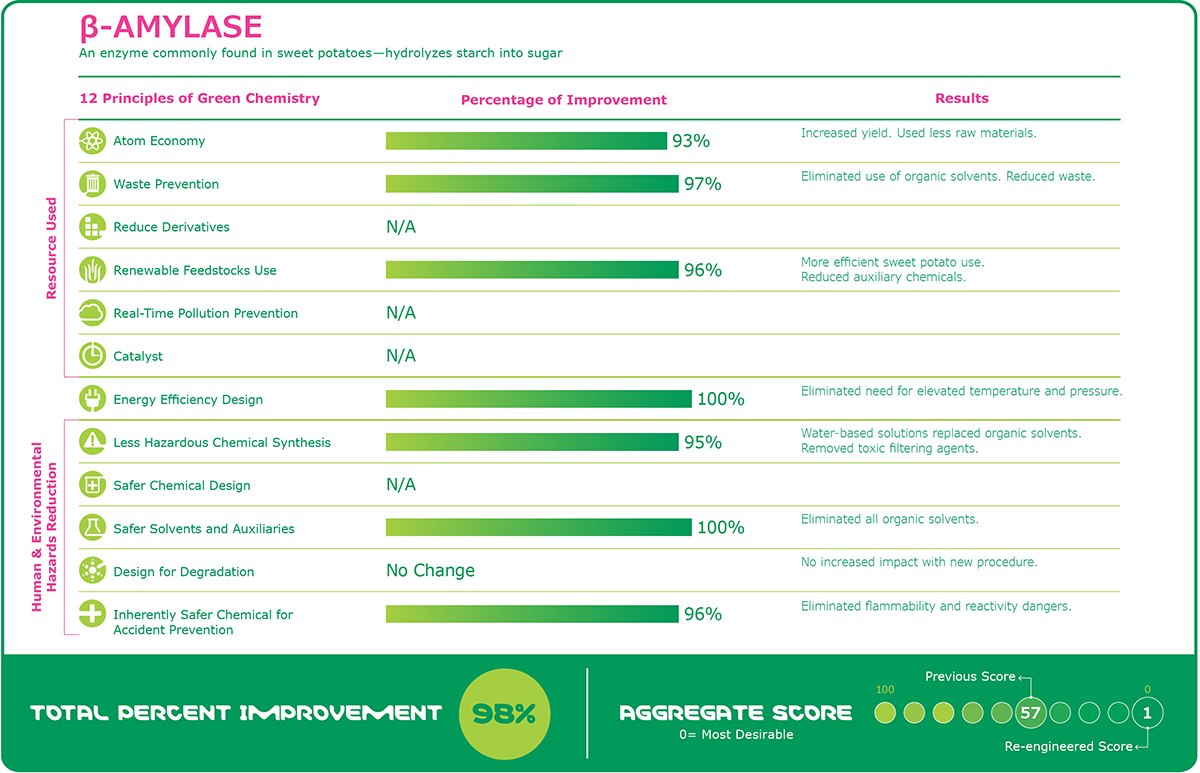Greener Alternatives Evaluation Matrix
Our approach to evaluating greener chemicals is based on the 12 Principles of Green Chemistry. We recognize that these principles distill into three major categories: improving resource use, more efficient use of energy, and minimizing human and environmental hazards. At present, we are not incorporating lifecycle impacts of raw materials (ie raw material extraction, pre-processing and manufacture), but we are considering hazards of and the efficient use of such materials.
Our approach intends to share with customers our view on product performance aligned with each Principle, as well as within the three larger categories. Below we present each Principle and our approach to quantify a green score for the Principle.
DOZN™ Scoring Example

1. Prevention
It is better to prevent waste than to treat or clean up waste after it has been created.
Principle 1 drives an overall approach to resource efficiency by considering the relationship between all input materials to a process (reactants and auxiliaries) and the desired product produced. Other Principles, such as 2, 5, 8, 9 etc. drive specific elements or approaches to resource efficiency. We are exploring approaches that allow us to variously weight more and less desirable waste management tactics.
2. Atom Economy
Synthetic methods should be designed to maximize the incorporation of all materials used in the process into the final product.
While Principle 1 focuses on all input materials, we have crafted our approach for Principle 2 to focus on finding opportunities to reduce the amount of reactant used to produce the desired product.
In Principles 3, 4, and 5 we evaluate both the amount and toxicity of the various components of chemical synthesis, specifically raw materials, products, and solvents as detailed herein.
3. Less Hazardous Chemical Syntheses
Wherever practicable, synthetic methods should be designed to use and generate substances that possess little or no toxicity to human health and the environment.
Our approach for Principle 3 is to reduce average amount and toxicity of raw materials used per kg of product. We recognize the many forms of toxicity and have aligned our approach to our GHS. By aligning with the GHS, we optimize both the efficiency and global relevance of our data collection process.
4. Designing Safer Chemicals
Chemical products should be designed to affect their desired function while minimizing their toxicity.
In Principle 3 we focus on using less toxic input materials, for Principle 4 we use the same GHS based approach to focus on the toxicity of the produced product. Recognizing that a chemical process may produce multiple products (“coproducts”), we are careful to consider the toxicity of products and co-products when we address this Principle.
5. Safer Solvents and Auxiliaries
The use of auxiliary substances (e.g., solvents, separation agents, etc.) should be made unnecessary wherever possible and innocuous when used.
We leverage the approach used for Principles 3 and 4, to focus on reducing the amount and toxicity of solvents and other separation agents used per kg of product.
6. Design for Energy Efficiency
Energy requirements of chemical processes should be recognized for their environmental and economic impacts and should be minimized.
We are developing an estimation of energy impact by considering the amount of time synthesis steps deviate from ambient pressure and temperature.
7. Use of Renewable Feedstocks
A raw material or feedstock should be renewable rather than depleting whenever technically and economically practicable.
We prioritize the use of renewable feedstocks when practicable. For this Principle we catalogue at a minimum whether bio-based feedstocks are in use.
8. Reduce Derivatives
Unnecessary derivatization (use of blocking groups, protection/ deprotection, temporary modification of physical/chemical processes) should be minimized or avoided if possible.
We recognize that each derivatization step require additional reagents and can generate waste. Our aspiration for this Principle is to develop a process to catalogue reductions in derivatization waste either directly or by proxy.
9. Catalysis
Catalytic reagents are superior to stoichiometric reagents.
Our aspiration for this Principle is to develop a process to catalogue where the use of a catalyst reduces waste either directly or by proxy. Principle 9 serves as a compliment to Principle 2, likely driving improvements in atom economy via the specific route of catalyst use.
10. Design for Degradation
Chemical products should be designed so that at the end of their function they break down into innocuous degradation products and do not persist in the environment.
We approach Principle 10 with a recognition that we need to account for whether a product is readily biodegradable, as well as the hazards of biodegradation products. We default to GHS environmental hazard criteria for parent and degradation products.
11. Real-Time Analysis for Pollution Prevention
Analytical methodologies need to be further developed to allow for real-time, in-process monitoring and control prior to the formation of hazardous substances.
For Principle 11 we are incorporating an approach to recognize the value of process steps that incorporate process analytical chemistry, for example real-time, in-process analysis to detect changes in process temperature or pH for example. We recognize that the sooner deviations from plan are corrected, the less likely a process is to generate additional waste or cause additional hazard.
12. Inherently Safer Chemistry for Accident Prevention
Substances and the form of a substance used in a chemical process should be chosen to minimize the potential for chemical accidents, including releases, explosions, and fires.
The significance of principle 12 is to reduce the average physical hazards of raw materials per kg of product. We engage GHS physical hazard criteria across the range of hazard types such as explosivity, flammability, oxidizing capabilities and corrosivity.
Related Products
To continue reading please sign in or create an account.
Don't Have An Account?